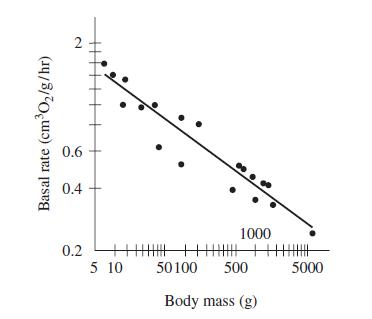The graph below shows the basal metabolism rate (in cm3 of oxygen per gram per hour) for
Question:
The graph below shows the basal metabolism rate (in cm3 of oxygen per gram per hour) for marsupial carnivores, which include the Tasmanian devil. This rate is inversely proportional to body mass raised to the power 0.25. (a) Estimate the metabolism rate for a marsupial carnivore with body mass of 10 g. Do the same for one with body mass of 1000 g.
(a) Estimate the metabolism rate for a marsupial carnivore with body mass of 10 g. Do the same for one with body mass of 1000 g.
(b) Verify that if the relationship between x and y is of the form y = axb, then there will be a linear relationship between ln x and ln y.
(c) If a function of the form y = axb contains the points (x1 , y1) and (x2 , y2 ), then values for a and b can be found by dividing y1 = ax1 b by y2 = ax2 b, solving the resulting equation for b, and putting the result back into either equation to solve for a. Use this procedure and the results from part (a) to find an equation of the form y = axb that gives the basal metabolism rate as a function of body mass.
(d) Use the result of part (c) to predict the basal metabolism rate of a marsupial carnivore whose body mass is 100 g.
Step by Step Answer:






